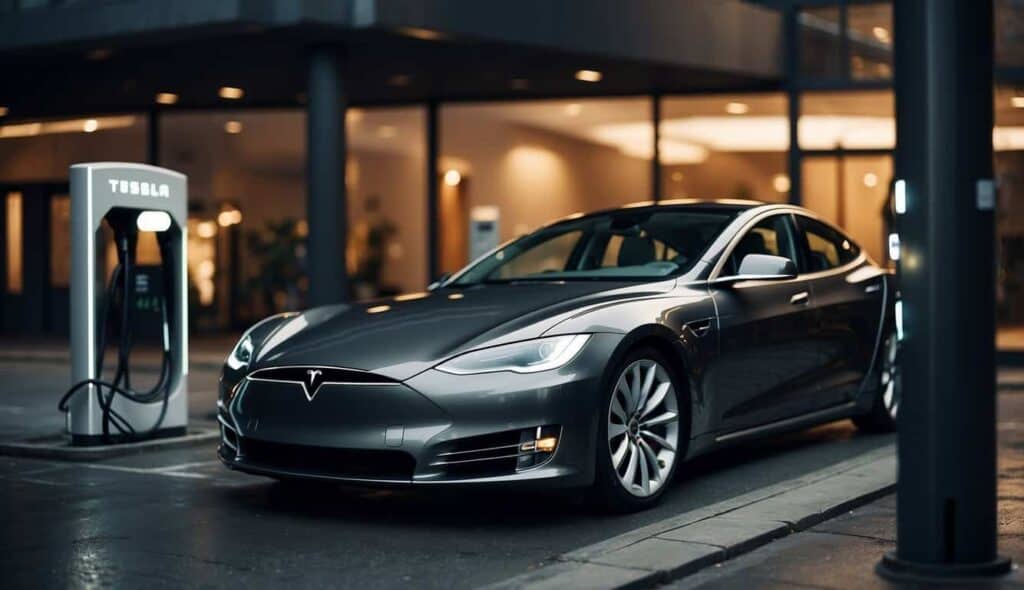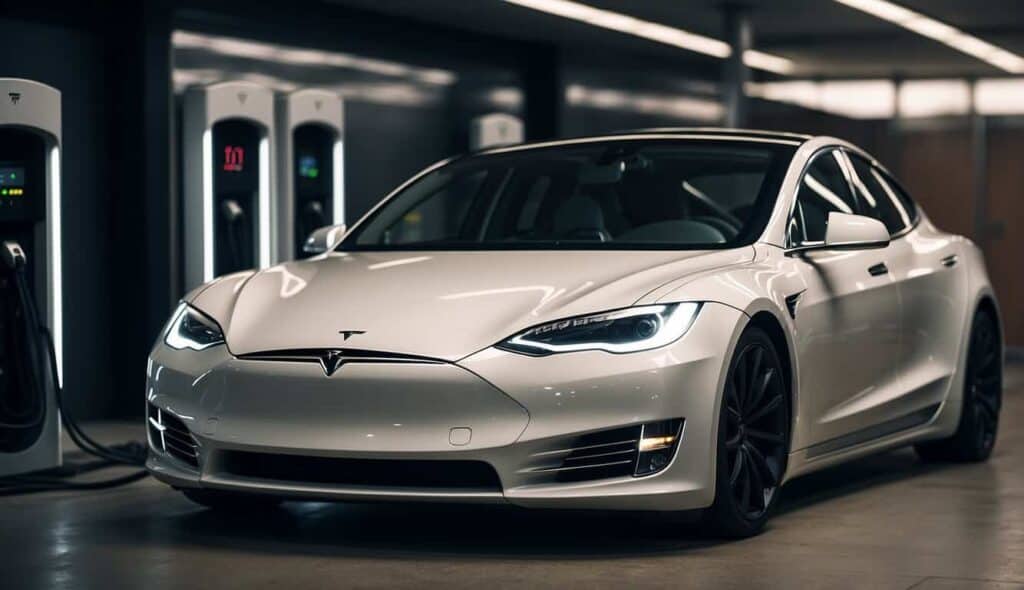Tesla owners may occasionally encounter situations where their electric vehicle is not charging.
One common reason for a Tesla not charging is that there is no power coming from the charging source.
It’s essential to check that the power outlet is functioning correctly and that the charger is properly connected.
Another possible issue could be with the charge port itself. For instance, the charge port status lights on a Tesla can communicate various states and help troubleshoot issues.
If the port light is off and the vehicle is locked, this could be a normal behavior as observed in many models.
Checking the status light can provide clues on whether there is a connection problem or an issue with the charger.
In some cases, resetting the vehicle’s systems may help.
This can be done by holding both scroll wheel buttons on the steering wheel until the center screen reboots.
This simple step might resolve minor software glitches that affect charging.
Basics of Tesla Charging
Charging a Tesla efficiently involves understanding the key components and processes of the charging system.
This includes how the charge port functions, the types of chargers available, and interpreting the charge port light indicators.
The Tesla Charging System Explained
Tesla cars, including the Model S, use a sophisticated charging system.
Charging is achieved using Tesla’s proprietary charging equipment like the Wall Connector and Supercharger, as well as other compatible public chargers. The car’s charging port connects to these with a charging cable.
Electricity from the charger is converted to power for the car’s battery.
The charging speed depends on the voltage and amperage of the power source.
Tesla owners often use a Wall Connector for better efficiency, which can provide faster charging than a standard outlet.

How the Charge Port Works
The Tesla charge port is typically located near the rear tail light.
When charging, the plug from the charger connects to this port.
Inside the port, a connector carries electricity to the battery.
The charge port is designed with smart features and is sealed to protect against weather.
The port can be opened through the Tesla app, inside the car, or by pressing on the charge port door.
Once the port is open and the charging cable is in, charging begins automatically if the charger is operational.
Differentiating Tesla Chargers
Tesla provides various charging solutions, each serving different needs.
The Mobile Connector comes with the car and allows for charging from standard outlets, but it is slow.
The Wall Connector is a home charger that provides much faster charging, as it can handle higher voltage and amperage.
Superchargers, found in public charging stations, are the fastest option and can charge a Tesla significantly in under an hour.
However, they are generally used for long-distance travel rather than daily charging due to their high power output and extensive network.
Interpreting the Charge Port Light Indicator
The charge port light on a Tesla is an important feature that communicates the car’s current charging status.
- White: The charge port is open and ready for a charging cable.
- Blue: The car is detecting the plug and communication is in progress.
- Blinking Green: Charging is actively happening.
- Solid Green: Charging is complete.
- Red or Amber: Indicates an error with the charger or the charging port.
These indicators help quickly identify whether the car is successfully charging or if troubleshooting is necessary.
Understanding these signals ensures that the battery remains optimally charged and any voltage or connection problems are promptly addressed.
Read Why Is Tesla Registration So Expensive?
Common Issues and Their Symptoms
When a Tesla isn’t charging, it can be due to several common issues. These include charging interruptions, color code signaling problems, physical obstructions, and electrical challenges.
Each issue has distinct symptoms that can help identify the cause of the charging problem.
Charging Interruptions and Incomplete Charges
Sometimes a Tesla may start charging but then stops intermittently.
This can happen if the plug is not fully inserted into the charge port. Users should hear a click when the plug is secure.
An imperfect connection might cause the car to charge off and on sporadically.
If the connector is partially plugged in, it leads to an unstable charging process.
Intermittent charging can also be due to software glitches, often resolved by rebooting the touch screen or updating the car’s software.
Other interruptions may occur because of a weak Wi-Fi signal, which disrupts the connection between the car and the Tesla servers.
Color Codes and What They Mean
Teslas use specific colors to signal the status of the charging process. These colors can help diagnose issues:
- Green: Charging normally.
- Blue: The car is detected, but charging has not started.
- Blinking Blue: The car is communicating with the charger.
- Amber: Partial connection; adjust the plug.
- Solid Red: Charging error; check both the connector and the charge port.
These color codes provide a quick visual indicator of the charging state and help users efficiently identify and troubleshoot issues.
Physical Obstructions and Connectivity Challenges
Physical obstructions can prevent the Tesla from charging properly. Dirt, corrosion, or damage on the connector or charge port can impede connection.
Often, cleaning the port or connector can resolve minor issues.
Another common problem is a damaged charging cable. The cable should be replaced immediately if it shows signs of wear or fraying.
Physical blockages in the charge port, such as debris, can also cause charging interruptions.
Ensuring both the charge port and the connector are clean and undamaged is crucial for maintaining a reliable connection.
Electrical Problems Impacting Tesla Charging
Electrical issues can also impact charging performance.
Sometimes, a blown fuse or a tripped circuit breaker can prevent the car from charging.
Checking home electrical systems or contacting an electrician can help resolve these issues.
Sometimes, there might be an internal problem with the Gen 3 Wall Connector.
Power cycling the Wall Connector by turning off the circuit breaker for a few seconds and then turning it back on can sometimes fix the issue.
If this does not work, contacting Tesla Energy might be necessary for advanced troubleshooting.
Check out Can Any Electric Vehicle Use a Tesla Charging Station?
Troubleshooting Steps for When Your Tesla Won’t Charge
When your Tesla isn’t charging, you need to go through several steps to pinpoint and perhaps solve the issue. This guide covers essential checks, app diagnostics, system reboots, and when to contact professional help.

Checking the Basics Before Seeking Help
Start by making sure that the charge port is clean and free of obstructions.
Ensure the wall connector is securely plugged into both the outlet and the car.
Verify that your circuit breaker hasn’t tripped; if it has, reset it.
It’s also crucial to check the voltage and amperage settings.
If the setting is too low, the car might not charge correctly. Adjust as needed for proper charging.
Using the Tesla App for Diagnostics
The Tesla App is a powerful tool for diagnosing charging issues.
Open the app and navigate to the charging section. There, you can see real-time data on the charging process, like voltage and amperage levels.
The app can also run a health check on the Tesla battery, which can identify if the problem is with the battery or the charger.
If a problem persists, the app will guide you through basic troubleshooting steps and may prompt you to contact support.
Resetting and Rebooting the Tesla System
Another common solution is to reset or reboot the system.
Press and hold both scroll wheel buttons on the steering wheel for about 10 seconds until the center screen reboots.
If the issue persists, turn off the circuit breaker supplying power to your wall connector, wait a couple of minutes, and then turn it back on.
When to Contact the Tesla Service Center
If you’ve gone through the above steps and your Tesla still won’t charge, it’s time to contact the Tesla Service Center.
Record your wall connector’s part and serial numbers, as this information will be required.
Sometimes, the issue could be due to a faulty component in the car that only certified electricians or Tesla technicians can fix.
Reach out to them for an expert diagnosis and repair.
Tesla’s Charging Features and User Management
Managing a Tesla’s charging features can maximize battery health, efficiency, and convenience.
Key aspects include scheduled charging, setting charge limits, using public and Supercharging stations, and managing accounts and billing.
Using Scheduled Charging to Your Advantage
Scheduled Charging helps users charge their Tesla at specific times, often when electricity rates are lower.
This feature can be activated through the car’s screen or the Tesla mobile app.
To set a charging schedule, navigate to the “Charging” menu and select “Scheduled Departure.”
Here, users can set the desired departure time, and the car will manage the charging process to finish at the optimal time.
For urgent needs, the timer override button can be useful to start charging right away.
Setting the Charge Limit for Optimal Battery Health
Setting a charge limit ensures the battery is not overcharged, which can degrade its lifespan.
Tesla recommends setting the charge limit to around 80% daily to preserve battery health.
To adjust the charge limit, go to the “Charging” section on the car’s screen and set the desired limit using the slider.
There are visual indicators to help users choose between daily and trip ranges.
Adjusting the charge limit is particularly useful when planning for long trips.
Utilizing Public Charging Stations and Supercharging
Using public charging stations and Tesla’s Superchargers is essential for long-distance travel and quick top-ups.
Tesla Superchargers are strategically located to support road trips, enabling fast charging rates.
To find a charging station, the Tesla navigation system includes options to search for nearby Superchargers and destination chargers.
Superchargers allow for rapid charging, providing up to 200 miles in about 15 minutes.
Users can also find public charging stations via third-party apps, which offer more flexibility and convenience.
Managing Your Tesla Account and Billing for Charging
Managing a Tesla account is important for tracking charging sessions and billing.
Users can access their charging history and manage payment methods through the Tesla app or online account.
To manage billing, go to the “Account” section of the Tesla app.
Here, users can view all their charging sessions, add or update payment methods, and set up automatic payments if applicable.
This feature ensures clear and easy handling of all transactions related to charging, whether at home or using public stations.

Additional Considerations for Tesla Charging
Understanding external influences, optimizing Tesla Model 3 charging efficiency, and properly maintaining charging equipment can significantly enhance your charging experience and extend your driving range.
External Factors Impacting the Charging Process
Several external factors can influence your Tesla charging process.
Power outages can interrupt charging, so checking your local power infrastructure is crucial.
Temperature plays a significant role; extreme cold may affect the thermal system, while excessive heat can impact the heat pump and charging speed.
Using a public charger may also introduce variability, as these can have differing energy units and charging speeds.
Additionally, ensure that the commissioning process is complete for any new installations. Lastly, power sharing when multiple vehicles are charging from the same power source can reduce the available power to each vehicle.
Maximizing Tesla Model 3 Charging Efficiency
Consider a few key practices to maximize the efficiency of your Tesla Model 3’s charging.
Regularly monitor the charging status and time remaining to ensure optimal charge cycles.
Charging during off-peak hours can also be beneficial, as there is less strain on the power grid and potentially lower electricity rates.
Additionally, using range-gain metrics can help you understand how much driving distance you can expect from a single charge.
Setting your daily charge limit to 80-90% helps maintain battery health. Try to avoid frequent charges to 100% unless necessary for long trips.
Maintaining Your Tesla Charging Equipment
Proper maintenance of your Tesla charging equipment is vital to ensure consistent performance.
Regularly inspecting the charging cable for wear and tear can prevent issues.
Keeping the charging port clean and free of debris helps facilitate a solid connection.
If using a Gen 3 Wall Connector, ensure it is fault-free and properly installed.
In case of issues, resetting the breaker or unplugging and replugging the charger can often resolve minor faults.
If the internal charger is faulty or if power issues persist, always refer to Tesla’s diagnostics and repair guidelines.
Conclusion
Charging issues with a Tesla can be frustrating but are often solvable with some basic troubleshooting steps.
First, check the charger, cable, and power outlet for any visible damage.
Dirty or damaged charging equipment can often cause problems. Inspect the cable for frayed wires or broken connectors.
Next, ensure the plug is fully inserted. A partially plugged-in charger can lead to intermittent charging.
Restarting the car and charging station can resolve many issues.
Turn off the circuit breaker, wait a few seconds, and then turn it back on.
For timer-related problems, adjust the settings through the car’s screen or charger app.
Some chargers have a timer override button that can start charging immediately.
If all basic troubleshooting fails, write down the charging unit’s part and serial numbers and contact Tesla Energy for assistance.
Common issues can also include the car not recognizing the charger or not starting.
In these cases, reinserting the cable or restarting the Tesla may help.
Using these strategies can help solve many charging problems. For persistent issues, professional help is recommended.

Hi, I’m Marybeth, an electric car enthusiast living in New York in the USA. As the owner of electriccartalks.com, I love sharing my knowledge on EV tips, battery maintenance, and charging solutions. As a proud Tesla owner, I blend my personal experiences with professional insights to offer valuable information to fellow EV enthusiasts. Through my articles, I aim to empower others to make informed decisions about their electric vehicles. Read more